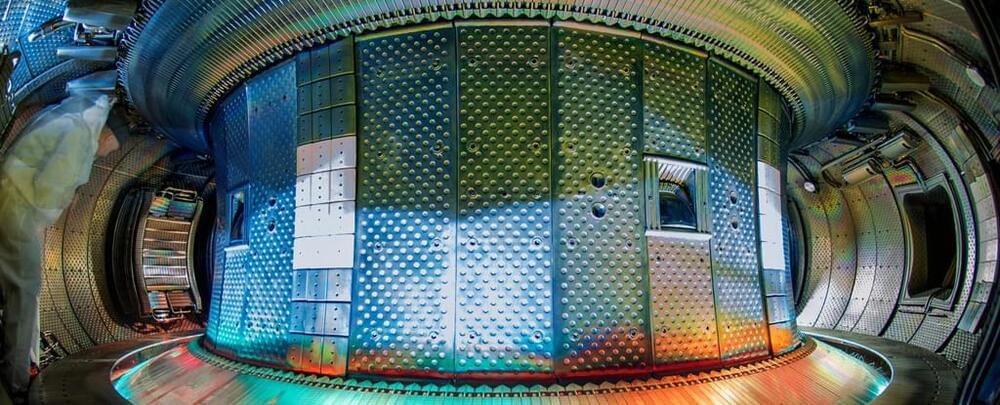This breakthrough in plasma stability brings the dream of endless energy even closer.




A fusion reactor in southern France, called WEST, just achieved an important milestone that brings us one step closer to clean, sustainable, nearly limitless energy.
Scientists at New Jersey’s Princeton Plasma Physics Laboratory, who collaborated on the project, announced today that the device created a super-hot material called a plasma that reached 90 million degrees Fahrenheit (50 million degrees Celsius) for 6 straight minutes.
The ultimate goal is to sustain a super-hot plasma for many hours, but 6 minutes is a new world record for a device like WEST. Other nuclear reactors similar to WEST have created hotter plasmas, but they haven’t lasted as long.

By Rachel Kremen, Princeton Plasma Physics Laboratory
Researchers at the U.S. Department of Energy’s (DOE) Princeton Plasma Physics Laboratory (PPPL) measured a new record for a fusion device internally clad in tungsten, the element that could be the best fit for the commercial-scale machines required to make fusion a viable energy source for the world.

In the nine decades since humans first produced fusion reactions, only a few fusion technologies have demonstrated the ability to make a thermal fusion plasma with electron temperatures hotter than 10 million degrees Celsius, roughly the temperature of the core of the sun. Zap Energy’s unique approach, known as a sheared-flow-stabilized Z pinch, has now joined those rarefied ranks, far exceeding this plasma temperature milestone in a device that is a fraction of the scale of other fusion systems.
A new research paper, published this month in Physical Review Letters, details measurements made on Zap Energy’s Fusion Z-pinch Experiment (FuZE) of 1–3 keV plasma electron temperatures — roughly the equivalent of 11 to 37 million degrees Celsius (20 to 66 million degrees Fahrenheit). Due to the electrons’ ability to rapidly cool a plasma, this feat is a key hurdle for fusion systems and FuZE is the simplest, smallest, and lowest cost device to have achieved it. Zap’s technology offers the potential for a much shorter and more practical path to a commercial product capable of producing abundant, on-demand, carbon-free energy to the globe.
“These are meticulous, unequivocal measurements, yet made on a device of incredibly modest scale by traditional fusion standards,” describes Ben Levitt, VP of R&D at Zap. “We’ve still got a lot of work ahead of us, but our performance to date has advanced to a point that we can now stand shoulder to shoulder with some of the world’s pre-eminent fusion devices, but with great efficiency, and at a fraction of the complexity and cost.”

Researchers use a laser to excite and precisely measure a long-sought exotic nuclear state, paving the way for precise timekeeping and ultrasensitive quantum sensing.
Any reliably produced, periodic phenomenon—from the swing of a pendulum to the vibrations of a single atom—can form the basis of a clock. Today’s most precise timekeeping is based on extremely narrow electronic transitions in atoms, which resonate at optical frequencies. These stupendously precise optical atomic clocks lose just 1 second (s) in about 30 billion years. However, they could potentially be outperformed by a nuclear clock, which would instead “tick” to the resonant frequency of a transition that occurs in the atomic nucleus instead of in the electronic shell. The most promising candidate for this nuclear standard is an exceptionally low-energy and long-lived excited state, or isomer, of the isotope thorium-229 (229 Th). Researchers have now achieved the long-sought goal of exciting this transition with ultraviolet light.
Try Opera browser FOR FREE here https://opr.as/eiiu-sabine-hossenfelder Last week I saw a lot of headlines about a space propulsion system that uses nuclear fusion. The news comes from a company by name RocketStar Inc. which announced in a press release that they have “reinvented” spacecraft by releasing the “world’s first fusion-enhanced space thruster, the FireStar™ Fusion Drive. They claim that the FireStar TM Fusion Drive improves their water powered pulsed plasma thruster by harnessing aneutronic nuclear fusion by 50%. In this video I explain what this all means. 🤓 Check out my new quiz app ➜ http://quizwithit.com/ 💌 Support me on Donorbox ➜ https://donorbox.org/swtg 📝 Transcripts and written news on Substack ➜ https://sciencewtg.substack.com/ 👉 Transcript with links to references on Patreon ➜ / sabine 📩 Free weekly science newsletter ➜ https://sabinehossenfelder.com/newsle… Audio only podcast ➜ https://open.spotify.com/show/0MkNfXl… 🔗 Join this channel to get access to perks ➜
/ @sabinehossenfelder 🖼️ On instagram ➜
/ sciencewtg #science #sciencenews #technews #technews #space #nuclear

Nuclear energy has long been regarded as a next-generation energy source, and major countries around the world are competing to secure cutting-edge technologies by leveraging the high economic efficiency and sustainability of nuclear power. However, uranium, which is essential for nuclear power generation, has serious implications for both soil ecosystems and human health.
Despite being a key radioactive material, uranium poses significant health risks due to its chemical toxicity to the kidneys, bones, and cells. As a result, both the U.S. Environmental Protection Agency and the World Health Organization recommend allowing and advocating for uranium concentrations in wastewater to be below 30 μg/L.
The Korea Institute of Civil Engineering and Building Technology (KICT) has conducted research on a nano-material-based adsorption process to efficiently remove uranium wastewater extracted from actual radioactive-contaminated soil. They have also proposed its applicability to prevent secondary environmental pollutions.

Two important barriers to a stable, powerful fusion reaction have been leapt by an experiment in a small tokamak reactor, but we don’t yet know if the technique will work in larger devices.
